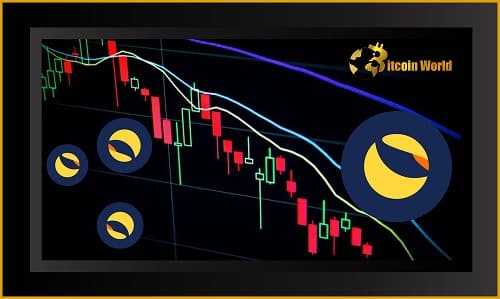Hold on tight, crypto enthusiasts! The crypto market has been hit by another wave of volatility, and this time, the spotlight is on Terra’s LUNA and its stablecoin, UST. If you blinked, you might have missed the wild ride LUNA took, plummeting to a low of $23.50 on Binance before clawing its way back to around $28. But the real drama? That unfolded with UST, Terra’s flagship stablecoin, which nosedived to an unprecedented $0.68, briefly recovering to $0.80. Remember when UST wobbled off its peg on Sunday? Well, things escalated quickly. What started as a slight deviation became a full-blown de-pegging, sending shockwaves through the crypto world.
Was UST Really Decentralized?
Let’s talk about UST. It’s not your typical stablecoin backed by good old US dollars sitting in a bank. UST is an algorithmic decentralized stablecoin. Sounds fancy, right? In simple terms, its dollar peg is supposed to be maintained by algorithms and market mechanisms, not by a central company like Tether holding actual dollars. The magic behind minting UST involves LUNA – you burn LUNA to create UST, and vice versa. This intricate dance is designed to keep UST anchored to that $1 mark.
Enter Luna Foundation Guard (LFG), the entity tasked with keeping UST stable. They have been deploying their hefty Bitcoin reserves, trying to prop up UST and restore its peg. Think of it as a firefighter using water to put out a blaze. However, in this case, the fire seems a bit too intense. Despite LFG’s efforts and massive Bitcoin holdings, UST is still struggling, currently down by a significant percentage. It begs the question: were LFG’s Bitcoin reserves enough to handle this crisis?
Cryptocurrency researcher Hasu raises a critical point: Is UST truly decentralized? He argues that while it’s called decentralized, its stability mechanism relies on discretionary open market operations by a single entity – the LFG. Essentially, the fate of UST’s peg rests on the decisions and actions of one organization, making its decentralization claim questionable in practice.
Terra’s ‘Bad Choices’ or Unforeseen Storm?
Did Terra make missteps that worsened the situation? Some analysts point to Terra’s decision to use its Bitcoin reserves to defend the UST peg as a contributing factor to the broader market downturn. As LFG sold Bitcoin to buy UST, it added selling pressure to the already shaky Bitcoin market, contributing to Bitcoin’s fall to a new yearly low of $29,731. It’s like using a volatile asset to stabilize another – a risky strategy in turbulent times.
FTX CEO Sam Bankman-Fried had previously warned about the inherent risks of stablecoins backed by volatile assets. His prediction seems to be playing out now, highlighting the vulnerability of such models during significant market stress. The UST situation isn’t unprecedented. Remember IRON, Iron Finance’s algorithmic stablecoin? It tragically plummeted to zero in June, serving as a stark reminder of the potential pitfalls of algorithmic stablecoins.
Key Takeaways from the Terra/UST Saga:
- Algorithmic Stablecoin Risks: UST’s de-pegging highlights the inherent risks associated with algorithmic stablecoins, especially their reliance on complex mechanisms that can fail under extreme market pressure.
- Decentralization in Question: The incident raises questions about the true decentralization of stablecoins that depend on centralized entities for stability interventions.
- Volatility Contagion: Using volatile assets like Bitcoin to back stablecoins can amplify market volatility, creating a feedback loop that exacerbates downturns.
- Investor Caution: This event serves as a crucial reminder for investors to exercise caution and understand the risks involved in all types of cryptocurrencies, including stablecoins. ‘Stable’ doesn’t always mean risk-free.
What Does This Mean for You?
If you’re a crypto trader, especially one involved with LUNA or UST, you’re likely feeling the heat. This situation underscores the importance of:
- Due Diligence: Thoroughly research any cryptocurrency project before investing, understanding its mechanisms, risks, and backing.
- Risk Management: Diversify your portfolio and never invest more than you can afford to lose, especially in volatile assets like cryptocurrencies.
- Staying Informed: Keep up-to-date with market news and developments, particularly in the rapidly evolving world of DeFi and stablecoins.
The Road Ahead for UST and Algorithmic Stablecoins
The future of UST and algorithmic stablecoins, in general, is now under intense scrutiny. This crisis may lead to:
- Regulatory Scrutiny: Increased regulatory attention on stablecoins, particularly algorithmic ones, is highly probable. Regulators may seek to impose stricter rules to protect investors and ensure market stability.
- Rethinking Algorithmic Models: Developers and researchers may need to revisit and refine the designs of algorithmic stablecoins to make them more robust and resilient to market shocks.
- Shift in Investor Sentiment: The UST de-pegging could lead to a shift in investor sentiment, with increased skepticism towards algorithmic stablecoins and a preference for more transparent and collateralized stablecoin models.
In Conclusion: A Lesson in Crypto Volatility
The Terra Luna and UST crisis is a stark reminder of the inherent volatility and risks within the cryptocurrency market. While stablecoins are designed to provide stability, algorithmic models like UST have proven to be vulnerable under extreme pressure. This event serves as a critical learning opportunity for the crypto community, highlighting the need for caution, thorough research, and robust risk management. As the dust settles, the industry will likely see increased discussions around stablecoin regulation, algorithmic design improvements, and investor education. One thing is certain: the crypto landscape is constantly evolving, and staying informed and adaptable is key to navigating its turbulent waters.
Related Posts – This was a major factor in Bitcoin’s (BTC) drop to $35,000
Disclaimer: The information provided is not trading advice, Bitcoinworld.co.in holds no liability for any investments made based on the information provided on this page. We strongly recommend independent research and/or consultation with a qualified professional before making any investment decisions.


